
May 2nd to 8th, 2024
Graz / Austria
2024
INTERNATIONAL DESIGN WEEK
1 THEME 7 DAYS 10 COUNTRIES 16 WORKSHOPS 19 LECTURERS 180 STUDENTS SCIENCE F®ICTIONS DESIGN
#01
MELANIE BEISSWENGER ANIMATING THE FUTURE
#02
MATTHIAS BEYROW BUT SERIOUSLY ... FOLLOWING THE CALL OF BEAUTY ... OR CELEBRATING THE COUNTERPARTY? #03
EYAL GRUSS SPECULATIVE CODING WITH AI (FOR NONPROGRAMMERS)
#07
EMILIO LONARDO SHAPED BY DESIGN
#09
CARLA MOLINS-PITARCH (IN)VISIBLE (IN) TANGIBLE EXPERIENCES
#10
#04
ALBERT HANAN KAMINSKI THE RASHOMON EFFECT
#05
#06
ANDREW KIVUMBI STEPHEN EXHIBITION DESIGN TREND
MICHAEL LEUBE GLITTER PUNK AND HIPPY CHIC: OXYMORONS OF THE PRESENT
#08
KATELIJN QUARTIER UTOPIA OR DYSTOPIA, REFLECTIONS ON SHOPPING IN THE FUTURE #11
NIKLAS RÖNNBERG & AHMET BÖRÜTECENE DESIGNING VISUALS AND SOUND FOR IMMERSIVE EXPERIENCES
#12
LUIS DANIEL MARTÍNEZ ALVAREZ OSCILLATIONS OF THE TOWER OF BABEL: THE SURREALIST VOICE OF THE ANIMATED GENRE VIEW THROUGH SOUND DESIGN
#13
BAHADIR UCAN 3D PIXEL ART (AR INTEGRATED) WORKSHOP #14
DANIEL UTZ FAST FORWARD
ÁLVARO SANCHIS GANDÍA & MELANI LLEONART GARCÍA
LUMINA 46, A SPECULATIVE DESIGN GAME
#15
NITZAN WAISBERG THE FUTURE OF TIME #16
ROGER WALK & LARS HARMSEN DOUBT IS NOT AN OPTION
03
®ICTIONS
INTRODUCTION INTERNATIONAL DESIGN WEEK
We are th®illed to present the International Design Week in its now 3rd edition at the Institute of Design and Communication at FH JOANNEUM University of Applied Sciences Graz.
After our initial editions "The Prepper" and "mutate or mute" once again we welcomed 19 international guests from our significant global partner university network supported by Design Month Graz in our UNESCO City of Design giving 16 workshops under the collective theme of "Design Science F®ictions". In one week, we experienced frictions of interdisciplinarity, fictions of design practice and scientific explorations as well as cultural exchange and collaboration. Having international design experts across all disciplines of design, undergraduate and postgraduate design students from our institute as well as from our international partner network at our institute hopefully sparked new narratives of common frictions and understandings through design. During the International Design Week we were committed to pushing boundaries of creative practice and resetting the traditional borders of disciplines and education levels.
The theme "Design Science F®ictions" blended elements of design thinking, speculative design, and science fiction to envision and propose innovative future scenarios, products, or systems. It harnessed the creativity and problem-solving capabilities of design to imagine how advancements in technology, society, and culture might shape the future. Design Science F®iction often incorporates narratives, visualizations, and prototypes to convey these speculative visions and allowed us to explore the potential utopian or dystopian impacts on both individuals and society as a whole.
BIRGIT BACHLER Head of Bachelor Information Design
DANIEL FABRY Head of Institute Design and Communication Head of Master Programs
F
DESIGN SCINCE F®ICTION
DESIGN SCIENCE F®ICTIONS refer to the interplay between envisioning speculative futures through design (science) fiction. It acknowledges the challenges and frictions that emerge during the creative process while also addressing the prevailing increase in science skepticism, fueled by diminishing trust in media and communication. Moreover, it points out the frictions that might occur when society-centered design approaches clash with economic interests and demands of creative industries to compete in a post-capitalist meltdown.
As a result, Design Science F®ictions represented a transdisciplinary and interdisciplinary methodology that embraced cross-media ideation and solutions. The workshops catered to students from diverse backgrounds and experience levels, emphasizing applied methodologies and a hands-on approach. Cross-media was the core setting of this week‘s workshops - i.e. animation x sound, film x storytelling, interactive x graphic, spatial x game, ...


05
F®ICTIONS
NETWORKING DAY

The 3rd International Design Week began on Thursday, May 2nd with a Networking Day that featured a series of mini lectures and workshops open to all staff of the Institute of Design and Communication.

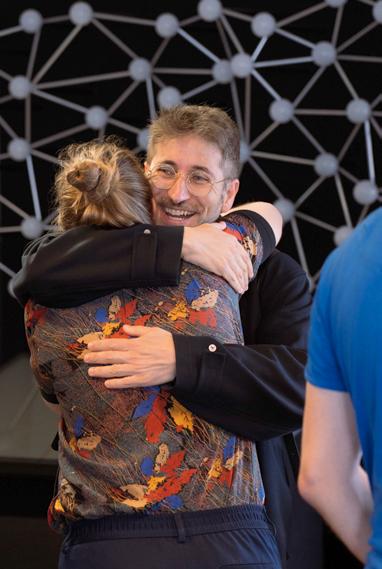
The day commenced with an inspiring talk by Hanan Kaminski from the Holon Institute of Technology, Israel, giving us a comprehensive overview of the evolution of animation cinema in terms of technique and aesthetics through his feature films over the past 40 years, followed by a glimpse into the future.
The second session on "Challengebased creative coding learning" by Carla Molins-Pitarch from UPC / CITM - Digital Design and Multimedia Technologies, Spain, provided insights into her teaching methodology and shared her challenging yet exciting journey, showcasing how to manage a class with very different backgrounds and varying (programming) skill levels, ranging from zero to experts.
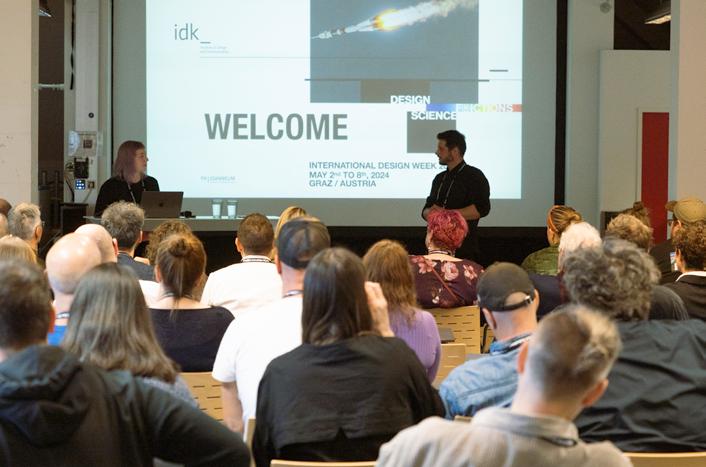
07
F®ICTIONS
NETWORKING DAY
In the subsequent session, titled "Real and Fake in the Age of Generative AI Imagery", Melanie Beisswenger from Ostfalia University of Applied Sciences, Germany, talked about how artists, animators and visual effects professionals create masterful illusions of reality in images and videos and if are we prepared to distinguish between real and fake in everyday life, now, as AI is capable of mass-producing images and videos.
Nitzan Waisberg from the Holon Institute of Technology, Israel, led a thoughtprovoking workshop on the theme of "Redesigning time". We explored how our experience of time is biologically determined and socio-technologically constructed of historical layers characterized by tensions between the natural and artificial, the individual and collective, and the legacy of the past versus the demands of the present.
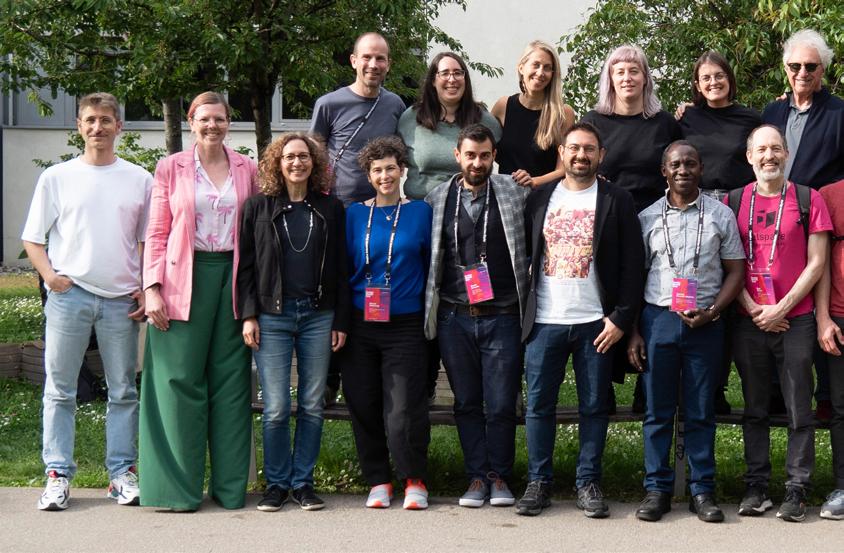



The Networking Day successfully kickstarted the International Design Week at the institute, delving into exciting design topics, contemporary creative challenges, and innovative teaching approaches.
09
#01 ANIMATING THE FUTURE
MELANIE BEISSWENGER, PROFESSOR, INSTITUTE FOR MEDIA DESIGN, OSTFALIA
UNIVERSITY OF APPLIED SCIENCES
SALZGITTER, GER
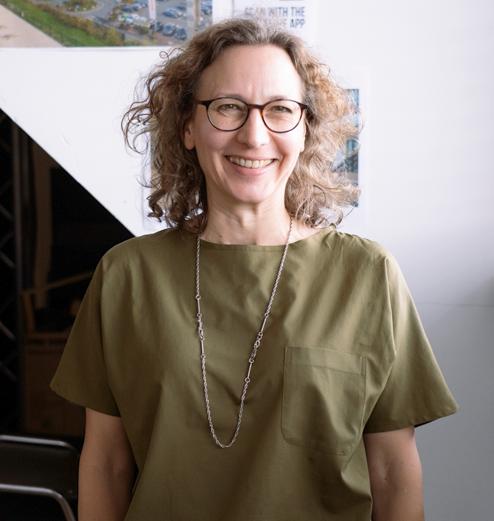
In the Workshop “Animating the Future” the students took on the challenge of creating short animations combining graphics, illustrations and moving type. The 11 projects address problems or propose solutions, and deal with issues and frictions they foresee in the near and far future. The topics include, among others, AI, social media, (intergalactic) relationships and the impact our behaviour has on our society and environment. While many students had never animated before, they all jumped in with great enthusiasm and motivation, learning different animation techniques. All the students did a fabulous job giving life to their ideas in their animations, making this a very joyful workshop experience for myself :-D
MELANIE BEISSWENGER
The workshop I attended during the International Design Week was really fulfilling and I had a lot of fun creating my animation. Despite my focus on communication design, I found animation to be surprisingly enjoyable. As I‘ve been a big fan of Disney and Pixar since childhood, it was both fascinating and inspiring to gain insight into the animation process behind some of the animated films and shorts. During the workshop, each of us created individual animated shorts in just three days. Despite the short time frame, the progress each of us made was remarkable and showcased our newfound skills in animation. This workshop has sparked a newly found passion for animation and a desire to further explore its techniques and applications. I am grateful to Melanie for her guidance and for creating such a beneficial experience.


11
ALVINA VASS CMSI23
#01
This workshop was amazing, really helpful and the teacher was awesome. She gave us good feedback and techniques to work with. Also, I really liked the references and the videos she showed us. Furthermore, everyone could share their ideas and opinions to other student works. I was able to learn other programs to animate.
MARTA ANICETO GUEST STUDENT UPV VALENCIA
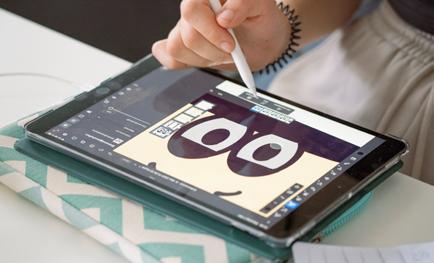
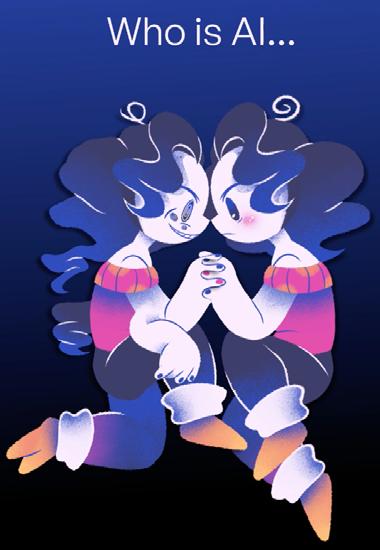


The workshop began with an introduction to animation‘s fundamental principles, from squash and stretch to anticipation and timing. Learning these principles offered insight into bringing static images to life. Melanie showed us various animation styles and approaches and always followed up with a discussion of the techniques used. One aspect of the workshop that I found particularly useful was the feedback sessions with Melanie. Her constructive criticism and encouragement helped me grow and identify areas for improvement.
TANNER GRYGUS
INCOMING STUDENT IND

13
#02
BUT SERIOUSLY...FOLLOWING THE CALL OF BEAUTY...OR CELEBRATING THE COUNTER PARTY?
 MATTHIAS BEYROW, PROFESSOR, DEPARTMENT OF DESIGN, POTSDAM UNIVERSITY OF
MATTHIAS BEYROW, PROFESSOR, DEPARTMENT OF DESIGN, POTSDAM UNIVERSITY OF
APPLIED SCIENCES, GER

SERIOUSLY...FOLLOWING
BEAUTY...OR COUNTER-
It‘s always great to work with students from different universities and different levels of experience. This was also the case in this workshop, which this year was designed as a think tank: which tasks for designers will probably be automated in the future - and for which new activities do designers need to be prepared?
Although the learnings worked exactly as planned, the students in this workshop probably missed the graphical, manual work that was offered in other workshops. The questions raised turned out to be understandably topical anyway and the participants of this think tank are left with a critical mental excursion into a rougher future as designers.
MATTHIAS BEYROW



15
#02
During the workshop we found problems in our daily life that we, as designers, could solve. After each of us presented one problem we decided on two to focus on. One was recycling information and the other one was hostile architecture. We discussed them in two groups and found out what could be done. During the workshop I learned the importance of finding, as graphic designer, real exhisting problems to solve and go beyond the simple graphics. It made me think about the possibility as a designer not only to create pretty designs, but think how I can make a real impact in the world and what are my responsibilities as a designer.
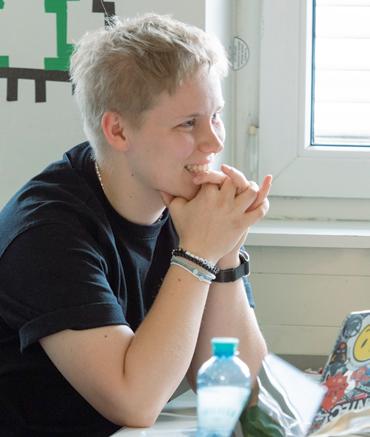

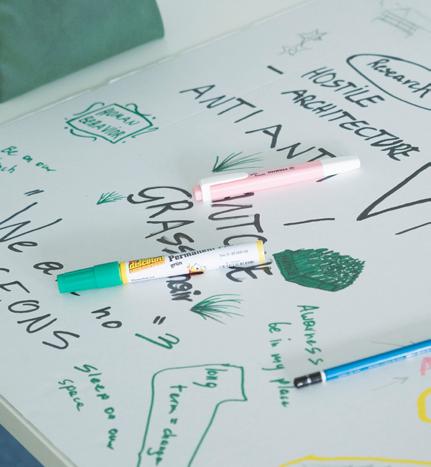 LAURA GALVANETTO CMSI23
LAURA GALVANETTO CMSI23


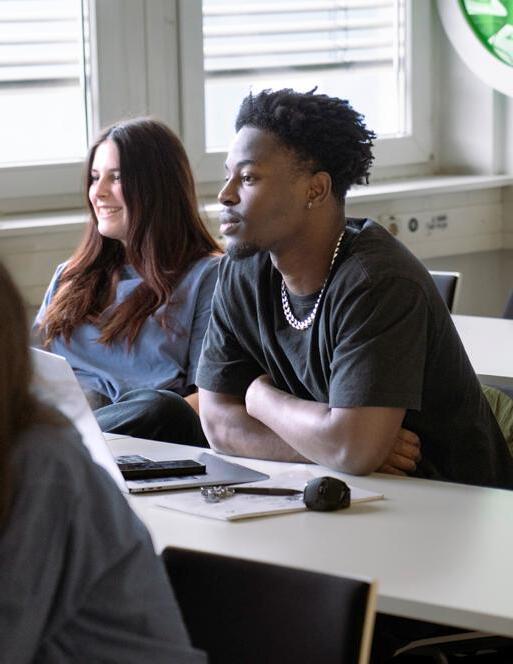
One of the highlights was the opportunity to learn from Matthias Beyrow, who stressed the significance of reflection before diving into the design process. His insights underscored that thoughtful consideration is crucial in creating meaningful and impactful designs. A particularly rewarding aspect was the final presentation, where we shared our learnings and project outcomes with the group. This exercise of presenting and discussing our work was invaluable, as it provided constructive feedback and different viewpoints that will undoubtedly influence our future projects.
17
VALERIA AUGELLO GUEST STUDENT UPV VALENCIA
#03 SPECULATIVE CODING WITH AI
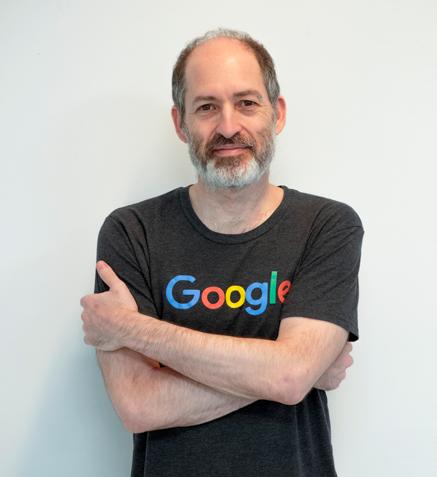
EYAL GRUSS, LECTURER, FACULTY OF DESIGN, HOLON INSTITUTE OF TECHNOLOGY, ISR
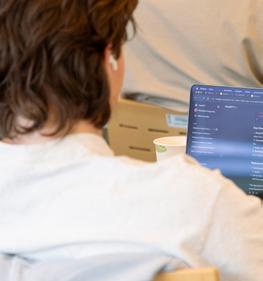
With no prior knowledge required, we used the power of large language models (GPT) to create websites and interactive experiences. We created websites, games, 3D, creative coding (p5.js), camera filters, virtual music instruments and interactive experiences involving face and body gestures. We did it with AI and we had the AI code new AI for us. But also, we learned how to use these large language models for both research and creativity, in controllable, critical and responsible manner. We understood the limitations of these tools and how to surpass them.
EYAL GRUSS
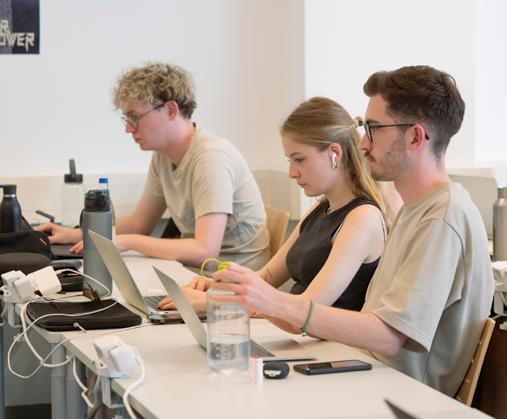

Very interesting workshop, fun to explore the capabilities of AI and use it as a coding companion.
GIOVANNI PACIFICO INCOMING STUDENT CMSI
We received a lot of insightful input regarding AI, particularly ChatGPT, and its applications. Following the discussion, we had the opportunity to apply what we learned through small exercises and culminated in a more extensive coding project. The experience was engaging and enjoyable for everyone involved.
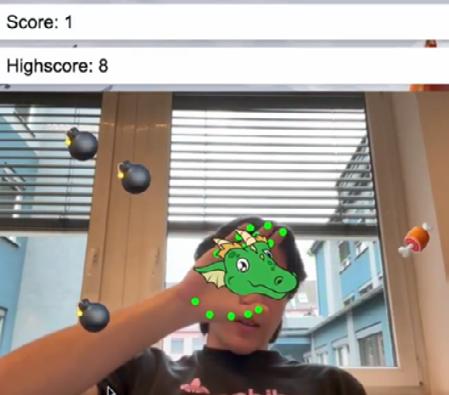
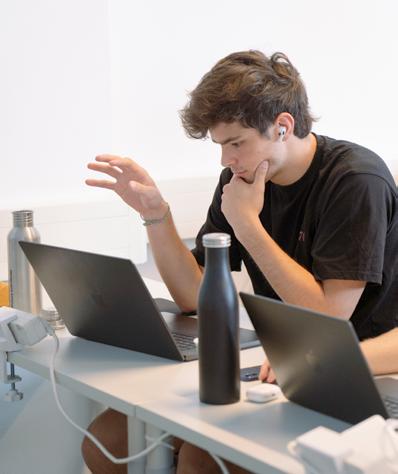
19
MERT ALTINÖZ CMSI23
#03

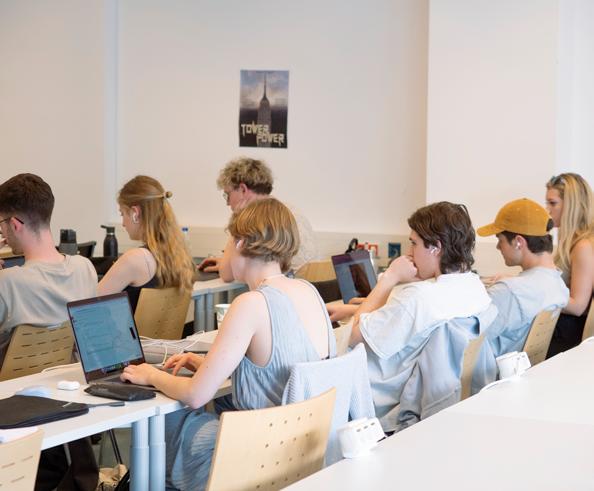

On the first day, we learned how to leverage ChatGPT, including some fascinating hacks. The last two days were dedicated to our projects, creating interactive websites using p5js, ml5, and ChatGPT. It was amazing how quickly I could develop a game, a task that used to take a whole semester.
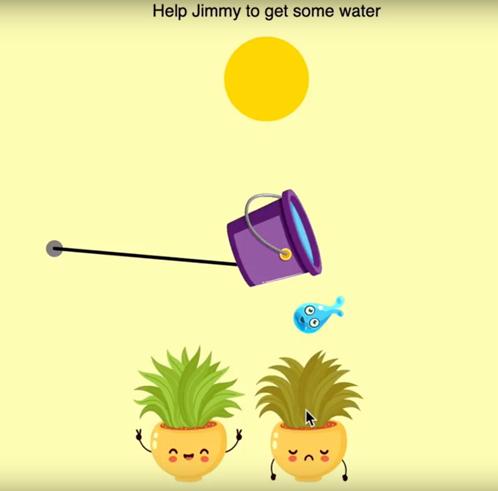
It was an interesting workshop where I learned how to communicate appropriately with an AI to get the code I need.
21
VINZENZ WEBER CMSI23
ELLEN DRESSLER CMSI23
#04 THE RASHOMON EFFECT
HANAN KAMINSKI,
HEAD OF THE MASTER PROGRAM IN DESIGN FOR TECHNOLOGICAL ENVIRONMENT, FACULTY OF DESIGN, HOLON INSTITUTE OF TECHNOLOGY, ISR

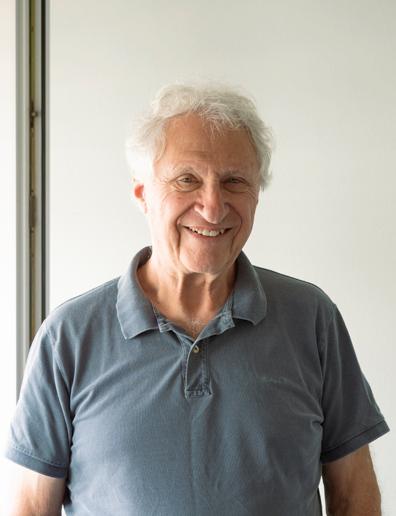

The Rashomon effect is a term used in filmmaking to show how a single event can be described in a variety of ways due to subjectivity of multiple witnesses. The 3-day storyboarding workshop asked the students to be scriptwriter, film director and film editor at the same time.
The first day of the workshop, I gave a lecture explaining the concept of "Rashomon effect", then the students were asked to write a story and a professional script using this effect in their story. The second day, I gave a lecture explaining the complexity of moving from one media to another (writing to visual). I showed them the tools and the methods used in a professional storyboard. The students were asked to draw a storyboard based on the script they have written. The third day of the workshop was focused on cinema language and how to build an animatic based on their storyboard. For that purpose, they had to record voices for the dialogues and build an original sound track including sound effects and music.
To complete their task the students had to make some homework between the different meetings of the workshop.
HANAN KAMINSKI
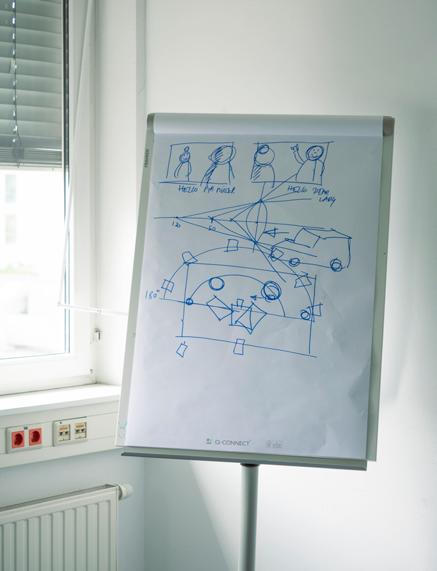

23
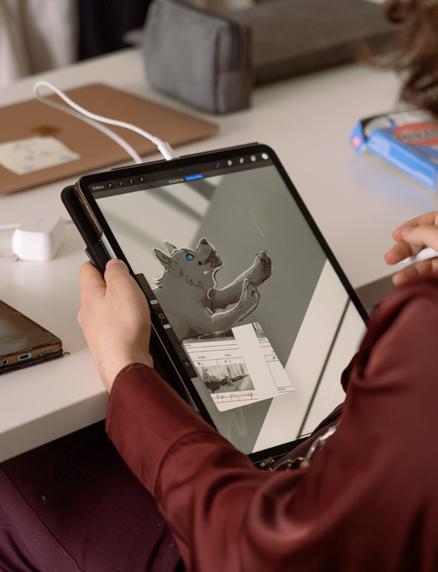
I really liked the topic, the interesting input in the morning and the work lessons afterwards. He gave useable feedback on our work. And he taught creating an inspiring artistic atmosphere, which was really motivating!
JASMIN MURTINGER IND23

Working with Hanan was an incredible experience. I had the best time learning. He had a lot of patience with each of us when we had a question. Our task was to produce an animated film, with or without audio. We learnt different camera perspectives and how to write a script. It was really an honor working with Hanan, his work was amazing and I could really tell the passion he had for this. He gave me so many advices. It‘s because of this workshop that I decided to buy my very first Ipad, Hanan gave me recommendations on which one to get. I discovered love for sketching and animation and I will pursuit in the future. I‘m very glad I got the opportunity to work in this workshop and I am very happy with the final outcome.
SAMANTHA ABRIL RAMIREZ LOPEZ INCOMING STUDENT IND
#04


After writing our own scripts about our own story we created thumbnails for some of the scenes. The next day we learned about storyboards and how different directors use storyboards to help direct their movies. We created our own storyboards and had to take notes as if we would actually direct our own stories. On the third day we mostly continued working on our storyboards and then turned them into videoboards. That day we also learned about composition and looked at scenes from different movies who used shot compositions or special sounds to highlight aspects in their scenes. The end results were videoboards about our own stories, directed and produced by ourselves.

25
NATHALIE PAVIC IND23
#05 EXHIBITION DESIGN TREND

ANDREW KIVUMBI STEPHEN, LECTURER, SCHOOL OF COMMERCIAL, INDUSTRIAL ART AND DESIGN, NKUMBA UNIVERSITY, UGA

The workshop assignment motivated the eleven participants at different academic levels to split into three smaller groups and blend the various concepts into one major project, which combined sustainability and environmental aspects in its idealized development.
On day one, the participants engaged in design consultancy or conceptualization that involved brainstorming insights and ideas that align with the community, a company or an existing business’ goal and objective. On day two, the participants engaged in concept innovation in their groups. The following day, the participants engaged in design development that utilized creativity to ensure that the image and text were visually engaging. It also involved ensuring that all aspects of development were executed and installed in a manner that may create public appreciation and impart knowledge.
Ultimately, the first group followed the guiding question of which Eco-Score people think Nestle would have. The scope covered products sold in our supermarkets, and they visually created interactive poster designs in different colours. The second group focused on how these products were branded. The third group idealized an app that goes along with the exhibition where, after signing up, one can look at various products in a local grocery market and see what company they belong to.
ANDREW KIVUMBI STEPHEN

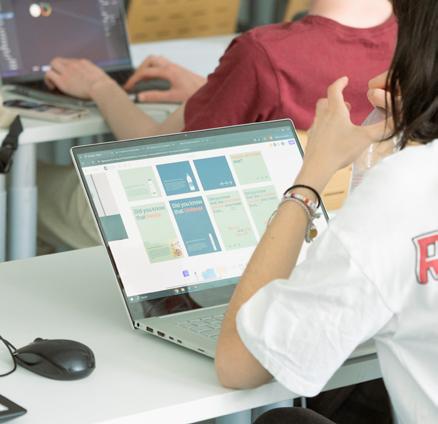
27
#05
In the workshop we were asked to design something that could improve our world or redesign something already made and improve it. We had a lot of freedom to choose the field of design we wanted to develop. We came up with the idea of rating companies based on how much they care about social aspects or sustainability. Then we produced posters, an interactive exhibition and an app. It‘s great to be able to do such a big project in such a short space of time.
IRENE AGULLÓ DOMINGO GUEST STUDENT UPV VALENCIA
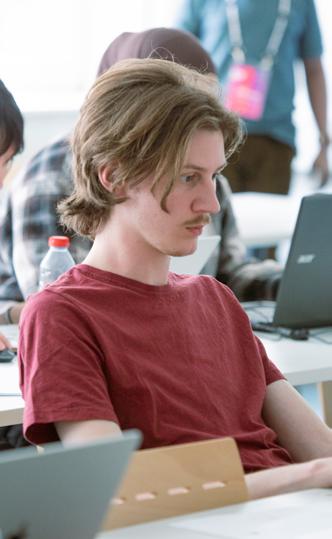




We produced a fictional exhibition where we tried to highlight the fact that around 8-10 major companies (such as Nestle, Danone, Montelez, Unilever, Coca-Cola etc.) dominate our local supermarkets and that we as customers don’t really have a choice but to consume these kinds of products. We especially tried to emphasize on the fact that the majority of these companies have been faced with severe allegations concerning child labor, unethical work environments, missed climate targets etc. We created a corporate design for our exhibition with posters, mock-ups, flyers and two fictional scores: the Green Grade and the Fair Factor. The aim of the exhibition was that visitors would guess these scores and then the actual rating would be revealed at the end.
LARISSA TEMMEL IND23
29
#06
GLITTER PUNK AND HIPPY CHIC: OXYMORONS OF THE PRESENT
 MICHAEL
MICHAEL
LEUBE, ADJUNCT
PROFESSOR,
SCHOOL OF ARCHITECTURE AND DESIGN, IE UNIVERSITY MADRID, ESP

The International Design Week was a beautiful and inspiring event. Was this surprising? No, because of the incredible mixture of international professors, students and design activities the week always stands out. My workshop aimed to look at the many contradictions of our confusing times. After much less than my usual theory, the students went to work looking for gorgeous recognisable symbols, which they then distorted by putting them into a new context.
I was very impressed by the motivation and creativity of the students and I believe that the workshop benefited from the fact that the group was a mix of students from different departments and backgrounds.
It is my hope that the international design week continues long into the future as I see it as an integral part of design eduction, for students and professors.
MICHAEL LEUBE

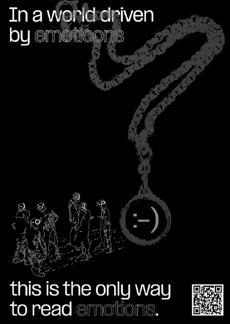
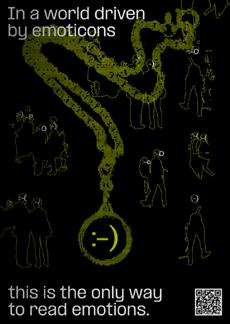

31
#06

During the workshop week, we produced an immersive performance about symbols in a dystopian future. I learned a lot about human perception, especially about the meaning of symbols and their origins. We as participants then split up into small groups and chose a symbol, which we then shifted 1000 years into the future and tried to come up with a scenario in which this symbol could have a very different meaning. We distorted a logo and created posters and speeches to show our new future society. Then, since our symbol was transformed into a sign for resistance we produced stencils and came up with a “corporate” clothing look for our performance.
LARS KÄHLER AUD23


A special highlight for me was the workshop led by Michael Leube, an anthropologist. Michael challenged us to imagine the future, to create new meanings for existing symbols, leaving us free to experiment. His lessons and insights were invaluable and pushed us to think about how to revolutionise our approach to product and service design.
CHECOLA GUEST STUDENT
POLITECNICO DI MILANO

33
ANNA
#07 SHAPED BY DESIGN
EMILIO LONARDO, ADJUNCT PROFESSOR, DIPARTIMENTO DI DESIGN, POLITECNICO DI MILANO, ITA
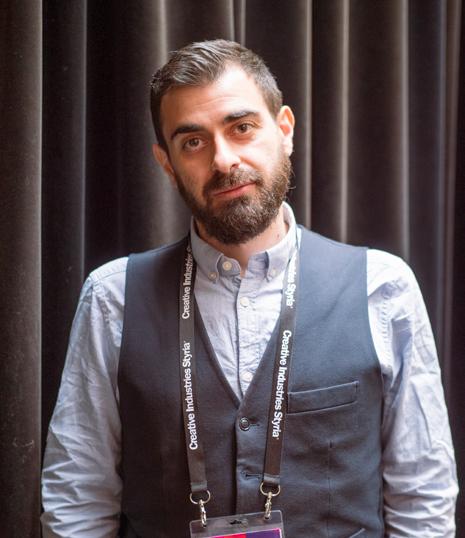
On my third participation in the International Design Week, the group increasingly feels like an extended family. The approach proposed in the previous two editions aligned perfectly with this year‘s theme, "Design Frictions", so I reprised the approach with differently tailored objectives. Using specific tools to analyze trends, build scenarios, generate ideas, and create business models, students examined the impact of design on various aspects of life, culminating in the presentation of three startup ideas. The "Shaped by Design" workshop followed the ABC(o)DE framework, which includes phases like Acquaintance, BuildUp, Continuation (or) Deterioration, and Ending. It was a privilege to work with such motivated students and share wonderful moments with the others.
EMILIO LONARDO
It was very interactive. I learned new ways to think about design for the future and how it impacts the world. I realized, the chance we have now, to change the world to a better one. We did many ice breaking activities, which I liked.
MARIA PUZZO AUD23

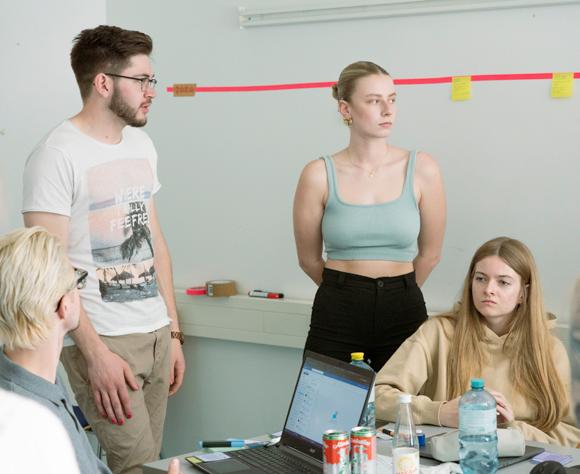
35
#07
I love the open and experimental approach of this workshop. I was not sure what to expect from the description of the course but I really appreciate the way the workshop was structured. There was a lot of impulses provided for new thinking strategies in design and I think I can take a lot for my further practice from this week!
HELENE GÖDL CMSI23




It was incredibly stimulating to be challenged to think outside the box. Stepping away from our usual routines and exploring different methods opened my eyes to new possibilities. I particularly loved the ice breaking exercises. They were a fantastic way to explain how the exercises helped, e.g., energize the group, create a sense of connection, or promote creative thinking.
MAXIMILIAN KATHAN

37
CMSI23
#08
OSCILLATIONS OF THE BABEL:THE SURREALIST THE ANIMATED GENRE SOUND DESIGN
LUIS DANIEL MARTÍNEZ ÁLVAREZ, LECTURER, DESIGN
DEPARTMENT, TECNOLÓGICO DE MONTERREY/ UNIVERSIDAD DE LAS AMÉRICAS PUEBLA, MEX
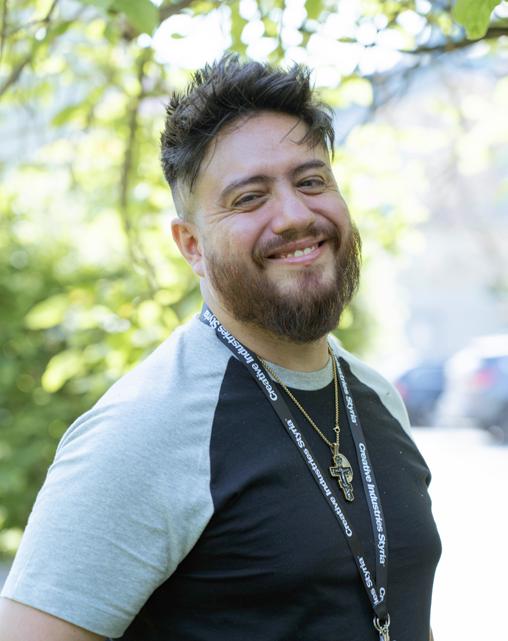
THE TOWER OF SURREALIST VOICE OF
VIEW THROUGH
The workshop brought together students from FH JOANNUEM and students from Mexico to collaborate with each other. The projects covered the topics of sound, dance, and animation, and the students even developed a playable firstlevel RPG-style video game.
The students demonstrated high quality and adaptability to the various narrative languages and especially those referring to music and sound. They also deeply reflected on the role of music in various visual media and the powerful impact sound has in conveying ideas and emotions.
LUIS DANIEL MARTÍNEZ ÁLVAREZ
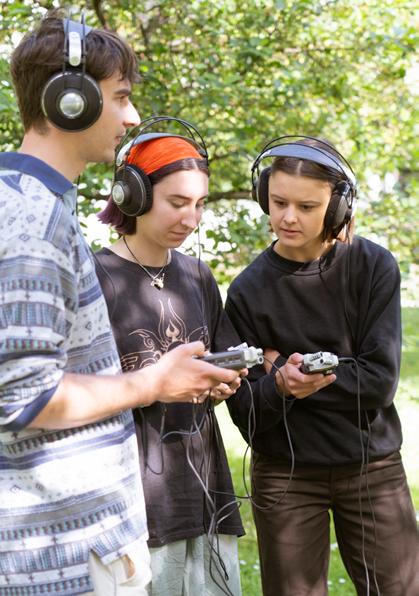

39
GENRE
#08

We made music for a video game and recorded sounds for it. We could work freely and outdoor. Thank you sooo much for this nice opportunity.

 HANNA WEICHSLER CMSI23
HANNA WEICHSLER CMSI23

The workshop was an unique experience! We learned how to create sounds using fruits and vegetables by crushing them and then recording with a dictation machine. It was fascinating to see the variety of sounds that can be produced from everyday objects. The highlight was definitely producing a music video for a selected song. In post-production, we edited the video to match the beat and aimed for a professional look. Overall, it was a creative and inspiring week.
LARISSA BINDER
IND23

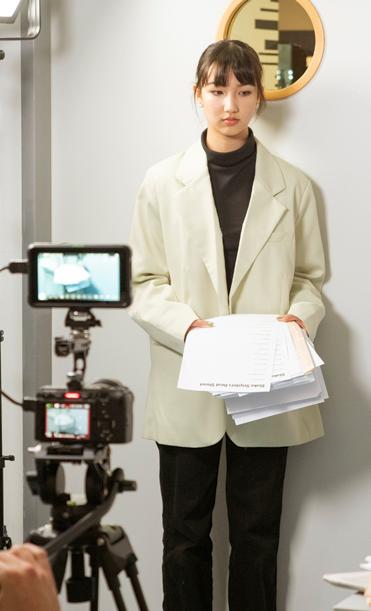
41
#09 (IN)VISIBLE (IN)TANGIBLE EXPERIENCES
CARLA MOLINSPITARCH, LECTURER & RESEARCHER, CITM - DIGITAL DESIGN AND MULTIMEDIA TECHNOLOGIES, UNIVERSIDAD POLITÉCNICA DE CATALUÑA, ESP

My workshop worked with the friction created between the seen & unseen and tangible & intangible. After some design thinking, 3 groups of students chose their themes of interest: the wealth gap, the internet, and feelings. The aim was to work around them to create experiences that would make these topics more approachable and comprehensible. A series of narratives, user journeys, and experiences have been designed and materialized thanks to electronics, and common materials like cardboard, skewers, pipe cleaners, and foam. After 3 days surrounded by lots of creative ideas and hard work, the students present fun and funky unique moments to experience abstract concepts in a surprising experiential way.
CARLA MOLINS-PITARCH
During the Design Week, I had the opportunity to take part in the workshop "(In)Visible (In)Tangible Experiences". My group chose the topic of "emotions" and we tried to make them tangible with the help of Arduino. After the weekend, we started the realization. We gave our project the name "Mixed Feelings" and envisioned a "DJ booth" for feelings. In the end, we had a prototype that two people had to use, one could ask the other a question (e.g.: How do you feel when you are alone?) which then had to be answered with our device. The device had different potentiometers for different feelings and as soon as you turned one of them, a motor started. This made it possible to communicate your feelings to someone without talking to them. Overall, I really enjoyed the design week and had a lot of fun working with new people and tools.
LOU KLEINHAPL
IND23


43
#09

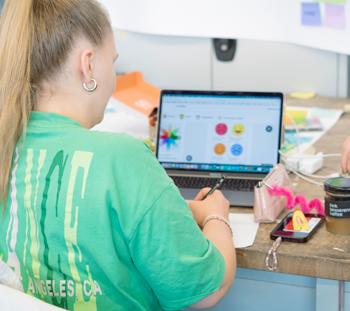
Carla was very kind and welcoming. The design was supposed to be done by programming. Of course, it was not mandatory in this regard. We had to design something that is interactive and intangible at the same time. We wanted our design to be based on a game that is both fun and interactive. Because our topic was inequality in society, we wanted to design a game where no one can win the game. So the player gets bored and our message gets across. After various ideas, we decided to get inspiration from the Wheel of Fortune.
FOROOZAN BITARAFHAGHIGHI AUD23




45
#10
UTOPIA OR DYSTOPIA, REFLECTIONS ON SHOPPING IN THE FUTURE.

KATELIJN QUARTIER, ASSOCIATE PROFESSOR, FACULTY OF ARCHITECTURE AND ARTS, HASSELT UNIVERSITY, BEL

Today, designs for retail are centered on society and those who shop. Indeed, it is the consuming people who determine whether or not a store or brand will continue to exist. During this workshop we explored how multi-media and advances in technology can determine the future of retail. How will we shop in the future? We went to try to discover and shape our own futuristic view of retail.
On day 1 we explored different visions of the future followed by a look into the past. We thought about the bigger picture: how will we live, comment and work? On day 2 a vision of the future about shopping was explored through a brand that we know today. Day 3 we used to work out 1 vision per group for 1 brand so in the end we faced branding, economic aspects and societal challenges.


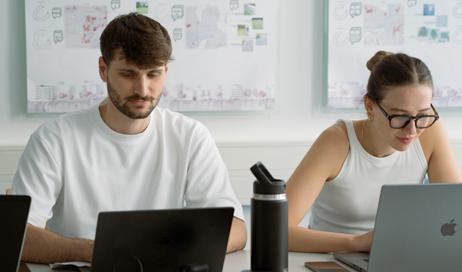
The workshop gave me a good insight into the field of shop design. In groups we created scenarios and personas that fit our own utopias/ dystopias. Also the theme of utopia/ dystopia really fit the workshop, and we had a lot of great brainstorm sessions in groups, with interesting outcomes and projects.
47
MAGDALENA HÖCHTL AUD23
KATELIJN QUARTIER
#10
The workshop focused on the future of branding in retail. Initially, we delved into envisioning our future selves and speculated about future scenarios concerning aspects like living, housing, work, and mobility across different time periods. We even crafted a narrative depicting a typical day in the future. Furthermore, we explored topics such as retail, brand DNA, and the branding pyramid, encompassing the ‚who,‘ ‚what,‘ and ‚how‘ of a brand. One notable activity involved creating an advertisement for a future company, where we developed a pyramid highlighting the brand DNA, persona, and a customer journey map comprising stages like awareness, consideration, acquisition, service, and loyalty. We were then encouraged to conceptualize a product or service that aligned with the customer journey.

 SELINA PARZAUNER IND23
SELINA PARZAUNER IND23


The aim of the workshop was to create a branding scenario using a persona for an existing brand. In order to achieve this goal, we first took a look at the past (100 years), the present and the future (100 years). Building on this, we used a scenario to describe a day in the future in which the focal points were to be incorporated. As the workshop progressed, we took a closer look at the branding focus and considered retail in the past, today and in the future. We incorporated the resulting content into the scenario we created in groups. We then created a storyboard for the scenario and created the Jane Duo persona. We used the customer journey to work out the brand‘s points of contact with consumers. On the last day of the workshop, we developed the storyboard "One day of June Duo and the marketing of Adidas in the future".
49 MIA
AUD23
FUNK
#11 DESIGNING VISUALS AND SOUND FOR IMMERSIVE EXPERIENCESCES

NIKLAS RÖNNBERG & AHMET BÖRÜTECENE, ASSOCIATE PROFESSORS, DIVISION FOR MEDIA AND INFORMATION TECHNOLOGY, LINKÖPING UNIVERSITY, SWE

During the workshop eleven students explored how to use smartphones for capturing images and sound for immersive storytelling depicting Graz in 2039 in three scenes. The workshop mixed lectures, brainstorming sessions, discussions, field work and practical exercises, with presentations and VR experiences. The work was done in teams consisting of students from different study programs and with different nationalities, and resulted in interesting stories using immersive visuals and audio that transformed today’s Graz into future settings and narratives. Two words frequently used by the students summarize their experience: Oh, cool!
NIKLAS RÖNNBERG, AHMET BÖRÜTECENE

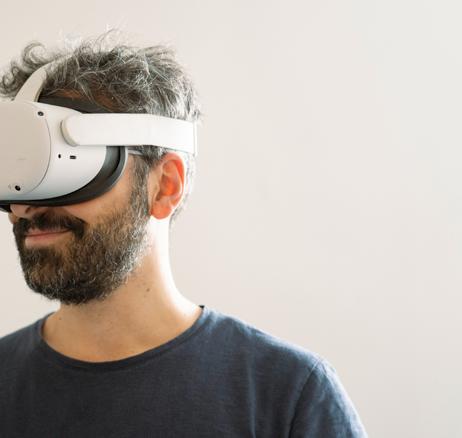
It was a lot of fun. Niklas and Ahmet approached us in a very friendly and easy-going manner, putting the focus on learnings and not performance.
ISIS POSPISCHIL IND23 51
#11
In general I have to say, that I really liked my workshop. We had so much fun with Ahmet and Niklas, they worked great together! We took 80-140 pictures around us for one 360° view. Back in the Uni, we startet to put our pictures together with lightroom and photoshop. We had so much fun while editing our 360° pictures from the present into our idea in 15 years. We especially used Photoshop AI to edit. We just tried it before a little bit but for our task we learned how to use it in another way. It was so nice to learn how to use all of that technologie and programs. The best part was taking VR glasses to see our worlds. I never did this before, it was mindblowing. Thanks to Ahmet and Niklas for laughing so much and helping with our questions!
MARLEEN AUE
GUEST STUDENT HFG SCHWÄBISCH-GMÜND


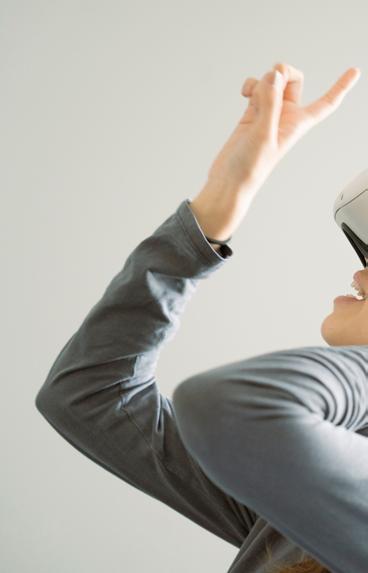

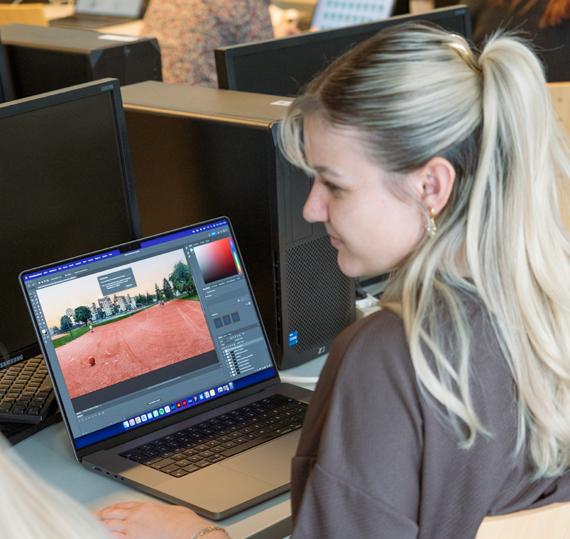

The workshop was such a great experience, with great new insights and workflows for immersive experiences. Niklas and Ahmet structured the workshop really well; they even made a website for it where everything we needed to know was on it. Niklas & Ahmet were great lecturers; they presented their input short and direct and always invited us to add our own experiences, opinions and views. They really motivated all of us to start discussions and brainstorm together. It was awesome.
53
STEFANIE WEBER CMSI23
#12 LUMINA 46 A SEPCULATIVE DESIGN GAME
ÁLVARO SANCHIS, PROFESSOR & MELANI LLEONART GARCÍA, ASSOCIATE PROFESSOR, DEPARTAMENTO DE PINTURA, FACULTAT DE BELLES ARTS, UNIVERSITAT POLITÈCNICA DE VALÈNCIA, ESP
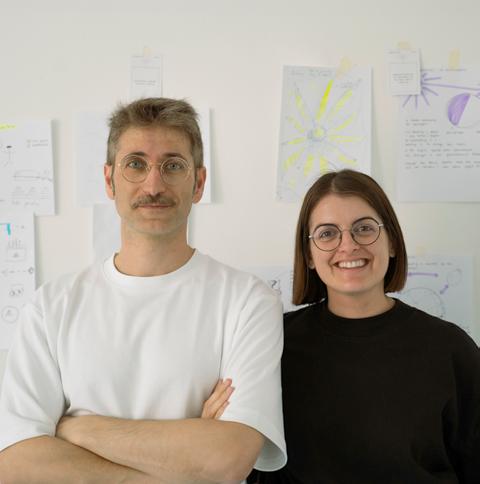
Lumina 46, a speculative design game, is a workshop that combines speculative design, storytelling, and game-based activities. In the first part, the students worked on design proposals based on the discoveries of Astrid Sage, a space explorer who ventures alone onto an unknown planet following the imminent collapse of Earth. From these discoveries, we have developed a collaborative experimental publication about future life on the planet Lumina 46, addressing sustainability issues, ethical considerations, and design implications. Lumina 46 Capsule for the Future compiles brochures, posters, and manuals describing life in a hypothetical new beginning for humanity on a different planet.
ÁLVARO SANCHIS, MELANI LLEONART GARCÍA
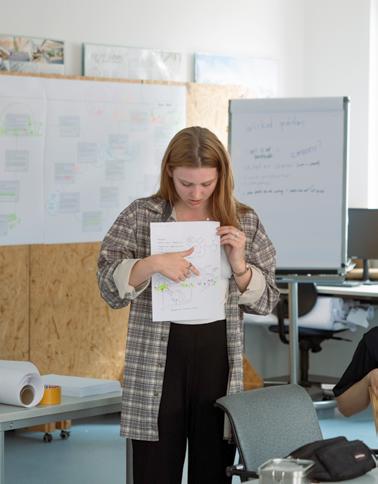
Our workshop teachers put a lot of effort into our workshop and they were very well prepared. I really enjoyed the workshop as we learned a new way of working creatively and interacted a lot with the other students due to discussions about our speculative design solutions. I was surprised how much we could learn by playing a design game.
JOHANNA GERDIKEN GUEST STUDENT FH DORTMUND
The workshop was the perfect mixture of playing and designing and every little detail was very well-prepared. We got to do a broad variety of tasks, like sketching gadgets, discussing ethical questions, constructing housing concepts, betting our earth credits at the earth bank and even flying a spaceship! At the end we designed posters, postcards, flyers and booklets to show our inventions which really tied everything together and helped to finalize our often crazy and rough 10-minute ideas.
JOHANNA STANGL IND23

55
#12


It was amazing and it was both educational and entertaining. The story was so interesting. We could create in a fun and practical way. The fact that they designed every single element was so impressive. Best workshop ever. Thank you so much.
TARANOM SEDGHI
AUD23



This workshop was about a simulated mission, where an astronaut went to a new planet. Each step on her journey revealed new challenges prompting collaborative design solutions depending on the obstacles the girl faced in this new place. Through this experience, I gained insights into designing for the future, with a lot of creativity, but always considering aspects such as sustainability, functionality, and aesthetics, that fit for this new planet.
VALERIA DE LOS ANGELES CALVO ARIAS INCOMING STUDENT IND

57
#13 3D PIXEL ART (AR INTEGRATED) WORKSHOP FOR
IMMERSIVE EXPERIENCES

BAHADIR UCAN, ASSOCIATE PROFESSOR, COMMUNICATION AND DESIGN, YILDIZ TECHNICAL UNIVERSITY, TUR
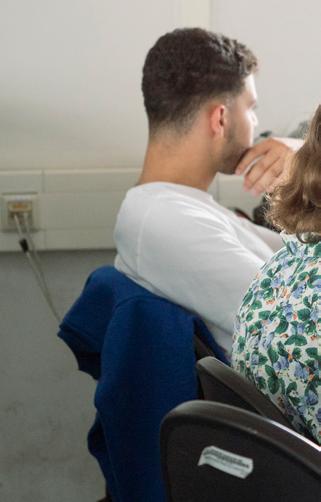
INTEGRATED) IMMERSIVE
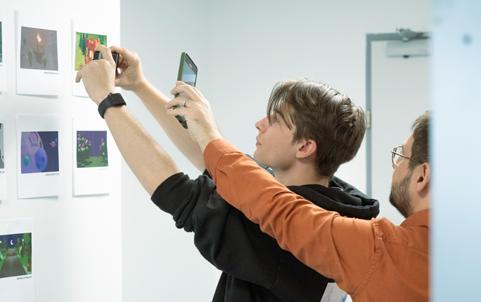
In my workshop, entitled "3D Pixel Art (AR Integrated) Workshop" I introduced the participants to the basics of Blender and 3D design. Basic topics such as Blender‘s interface, various rendering types, basic 3D modeling techniques, and materials were looked into. Topics such as modeling, lighting, and animation were covered. On our final day, three-dimensional pixel artworks were applied to augmented reality. The final works were augmented reality was integrated were thus static visuals that coul be viewed on tablets or cell phones as AR interactions. "Design Science Fiction" is extremely related to media and communication tools. In this sense, science-engineering and design come closer than ever. This workshop included both three-dimensional design skills and technology-based media tools. Three-dimensional design, modeling, animation, and augmented reality techniques were lectured to students on an introduction scale.
BAHADIR UCAN
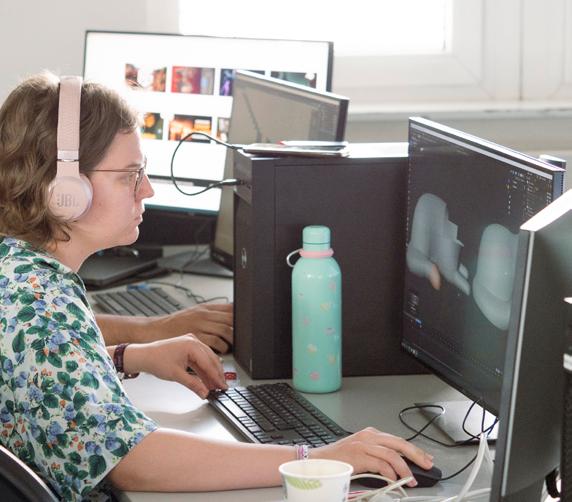
59
#13

At the International Design Week, I created a short animation featuring a cat in the park at night using Blender, accompanied by sound effects made in After Effects. I utilized the app Artivive to showcase the final piece.Overall, the experience was highly engaging.

I really liked our course and it was really fun. I found it good that we could work on our projects independently. I think our group did really good with the project and I really liked what the other groups came up with. It was interesting to see in the presentations what everybody was working on over the week and I think the cinema was perfect for presenting everything.
NADINE GRÖSSING IND23
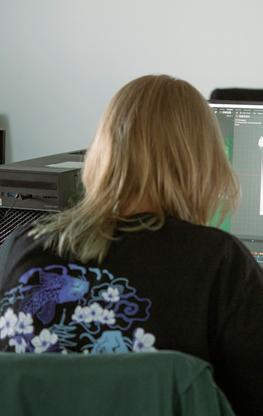 VIKTORIA KATTNER IND23
VIKTORIA KATTNER IND23




61
#14 FAST FORWARD
DANIEL UTZ, PROFESSOR, COMMUNICATION
DESIGN, HfG SCHWÄBISCH GMÜNDUNIVERSITY OF APPLIED SCIENCES, GER

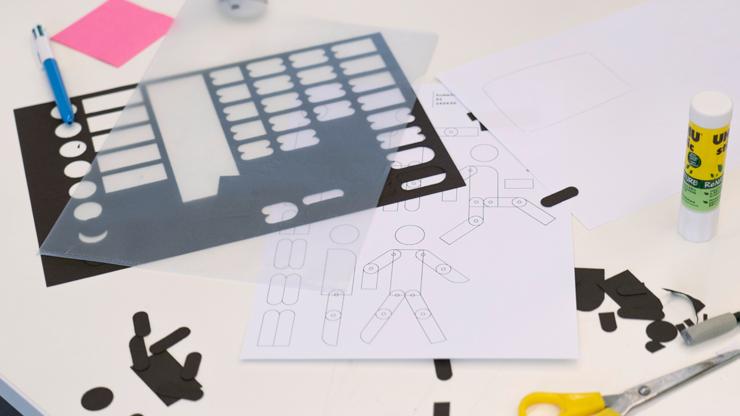
Paradise or apocalypse? Or something completely different? What might the world look like in the future? We speculated wildly, developed scenarios and then visualized them. With the help of self-designed characters: symbols, pictograms, icons and emoji. We combined these to create images that show our visions of the future in comparison to the everyday present.
"Predictions are difficult, especially when they concern the future." We still gave it a try and imagined how the world could look like in a few decades. To do this, we took a look at different topics: environment, economy, culture, technology.
... In which direction could individual sectors develop? Based on an analysis of the present, we developed scenarios for the future. These ranged from optimistic visions to scary dystopias. We then illustrated these possible futures using different signs: symbols, pictograms, icons and emoji.
As a result, we created pairs of images that showed the future in comparison to today. The images took many different forms: from illustrations to infographics, instructions for use, pictorial charts or comic stories. The different scenarios were then collected in a poster series.


63
DANIEL UTZ
#14
We worked with pictograms while reflecting on the future as a basis. On the first day, we experimented in an analogue way, creating images about the past and the present through stamping or using geometric paper cut-outs. The second day was all about brainstorming and sketching ideas for our infographic, which was to be the outcome of the workshop. We got to print out our posters, which depicted aspects of the past, present and future, using the Riso printer. I really enjoyed the workshop and particularly enjoyed the balance between free experimentation and productive work. Daniel Utz guided us well through this workshop so that we were able to create presentable infographics in this short time without it becoming too stressful.
MAIKE KLEMM CMSI23

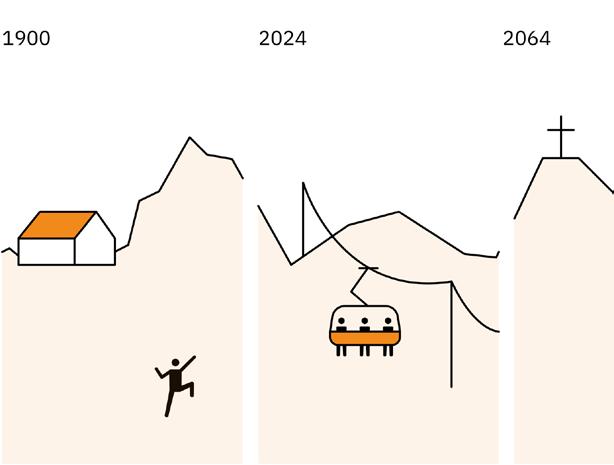


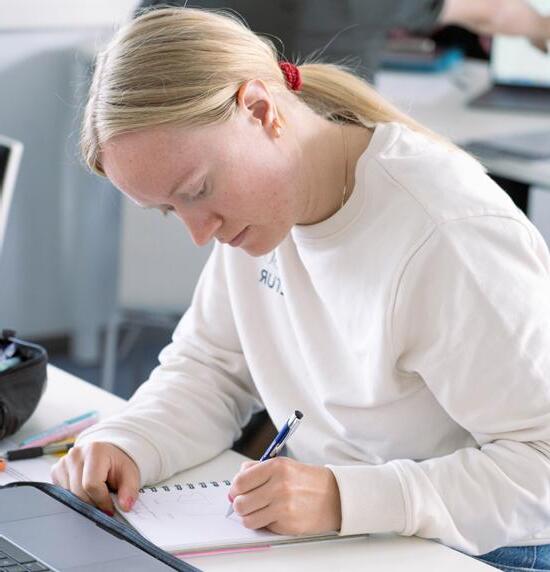
Throughout the workshop we learned about the history and use of different types of signs, from abstract symbols to emoticons. This workshop highlighted the power of visual communication in shaping our understanding of what‘s to come.
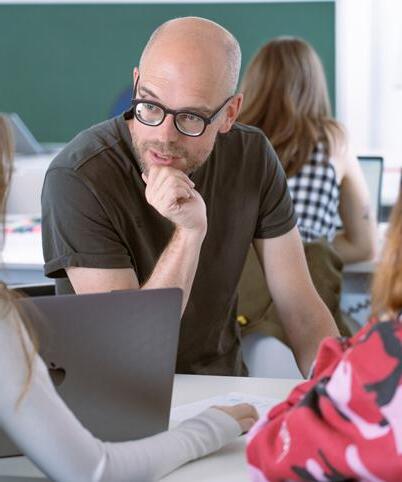
65
SELMA KURY CMSI23
#15 THE FUTURE OF TIME
NITZAN WAISBERG, LECTURER, FACULTY OF DESIGN, HOLON INSTITUTE OF TECHNOLOGY, ISR

Our experience of time is biological and cultural, natural and artificial, individual and collective. In our rapidly changing world, these tensions are intensifying. In the workshop we used humancentered design to envision humane solutions that increase wellbeing to future scenarios as they impact our experience of time.
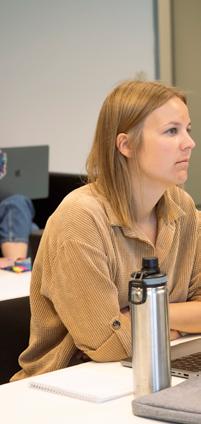 NITZAN WAISBERG
NITZAN WAISBERG
The workshop focused on redesigning our future perception of time using a human-centered approach. The schedule was very comprehensible and divided into three phases over three days: Understanding, Ideation and Prototyping. Each was structured with very helpful theoretical input in the morning, followed by individual working phases in groups in the afternoon, ending with a wrap-up of what was learned and achieved. As participants, we experienced freedom of choice in what we worked on, while at the same time being given some constraints to help us move forward in our work process. We learned to create personas and project them into future personas 50 years from now. Our group designed a vision in which people are empowered to pursue what they want in life through a framework of iterative cyclical learning as opposed to our current linear life plan. Throughout the workshop days, Nitzan was highly competent and supportive in guiding us to a result and responding to unexpected challenges in our group work.
TOM GIESS CMSI23


67
#15

I learnt a lot and it was really nice. The interaction, the way of teaching , the topic. It was amazing. I would have loved to have more time for more insights but unfortunately the time was short. At least we applied new stuff and ideas.

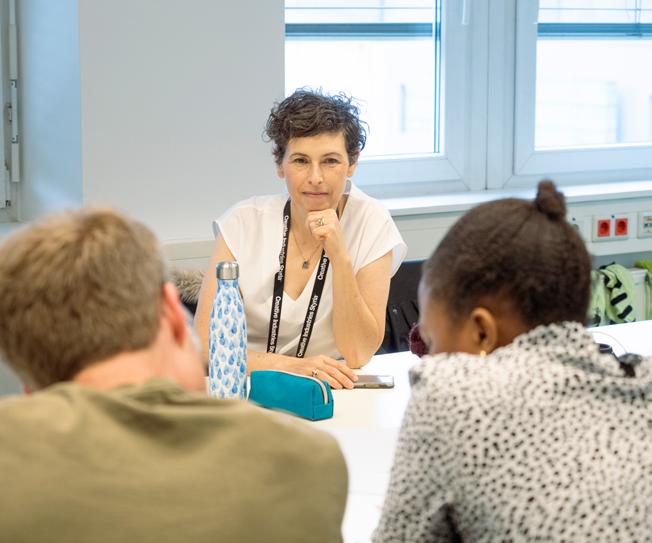 AIMEE NEYA CMSI23
AIMEE NEYA CMSI23

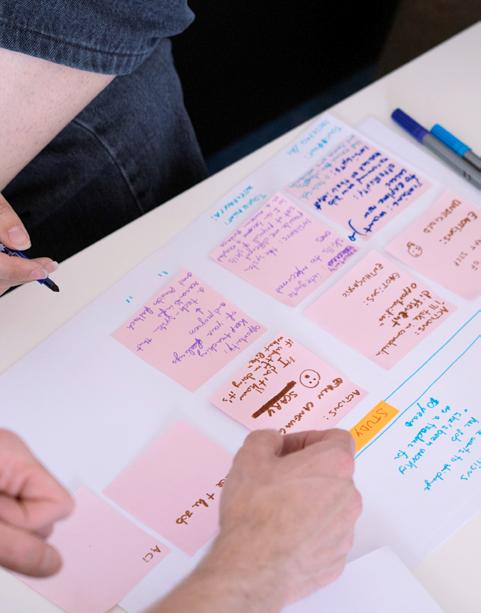

69
#16 DOUBT IS NOT AN OPTION
ROGER WALK, PROFESSOR FOR INTERACTION DESIGN & LARS HARMSEN, PROFESSOR FOR TYPOGRAPHY, DEPARTMENT OF DESIGN / COMMUNICATION DESIGN, FH DORTMUND UNIVERSITY OF APPLIED SCIENCES AND ARTS, GER

Our workshop "DOUBT IS NOT AN OPTION" dealt with the informational frictions in numerous societies, in particular the challenges of populism, disinformation and fake news employed by malignant actors. The aim of the workshop was to design a series of political statements / posters to address these manipulations and take a stand against the enemies of an open society, both external and internal. To counter these mass manipulation techniques, it is essential to understand their narratives and tools. Researching these techniques enabled us to identify patterns. By analyzing their tactics, we were able to develop strategies that are effective in countering these manipulations and promoting critical thinking. Our poster designs are the practical application of the ideas and concepts developed during the workshop. By creating impactful, bold designs, we were able to effectively communicate the importance of trust and (unconvenient) truth.
ROGER WALK, LARS HARMSEN

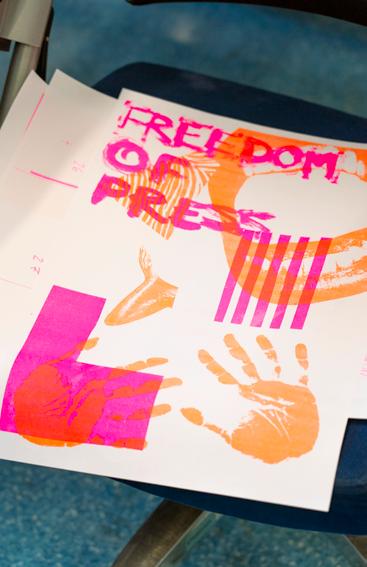
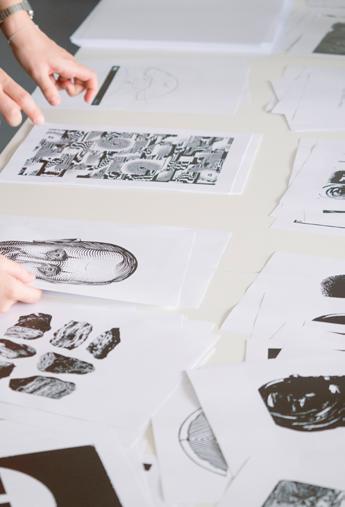
During the workshop, we embarked on a practical exploration of political expression, immersing ourselves in current political news and engaging discussions to shape our understanding. The first day was dedicated to comprehensive research, where we delved into newspaper articles. On the second day, we transitioned to the design phase, focusing on the creation of digital posters. Drawing inspiration from images and articles related to our topics, we crafted impactful visuals to convey our messages effectively. Finally, on the third and last day, we delved into analog techniques, such as risoprinting, collage, and axi-drawing, to create new posters. This emphasis on creative freedom fostered innovative ideas, resulting in a rewarding and enjoyable experience.
MICHELLE WETZ IND23
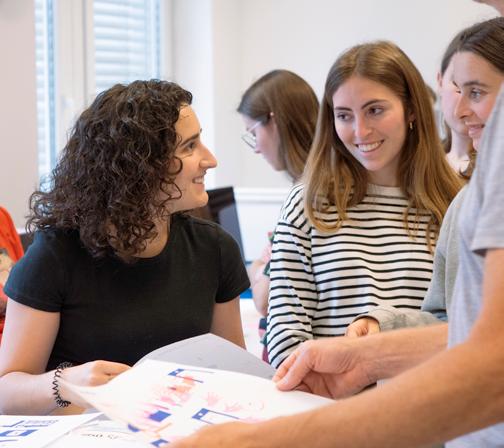
71
#16


I feel immensely fortunate to have had the opportunity to live through this experience and would undoubtedly recommend it. Learning from Lars and Roger was amazing, as they helped me expand my horizons and explore design techniques that I hadn‘t been able to experience yet. Seeking meaning in what we do while still enjoying the process. Thank you very much for everything.
CARLA RIBERA NIÑEROLA GUEST STUDENT UPV VALENCIA
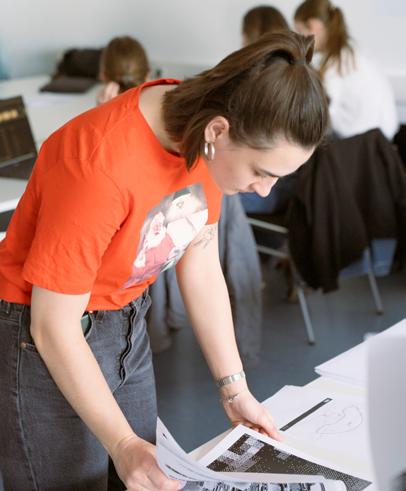
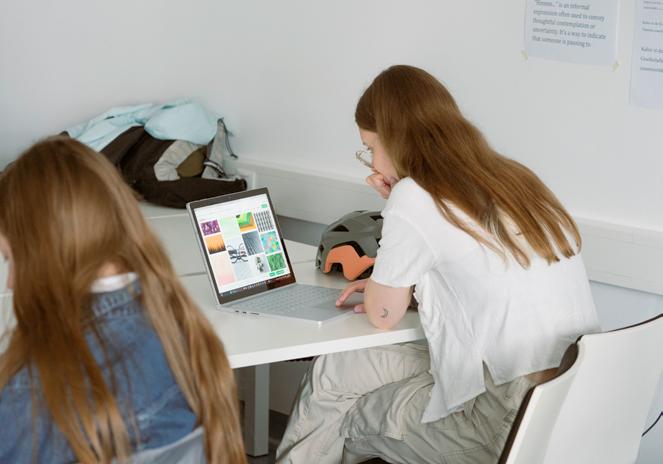


73
FINAL PRESENTATION F®ICTIONS



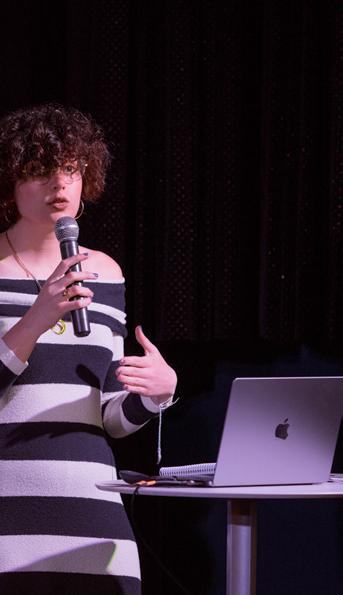
The climax of this year`s International Design Week with its 16 workshops taught by our 19 guest lecturers from around the world were the final presentations at Schubertkino in the heart of Graz.
There the students showed the results of their transdisciplinary cross-media work on the subject of "Design Science F®iction" within the areas of communication, media, sound, interaction, and exhibition design.

75
FINAL PRESENTATION F®ICTIONS
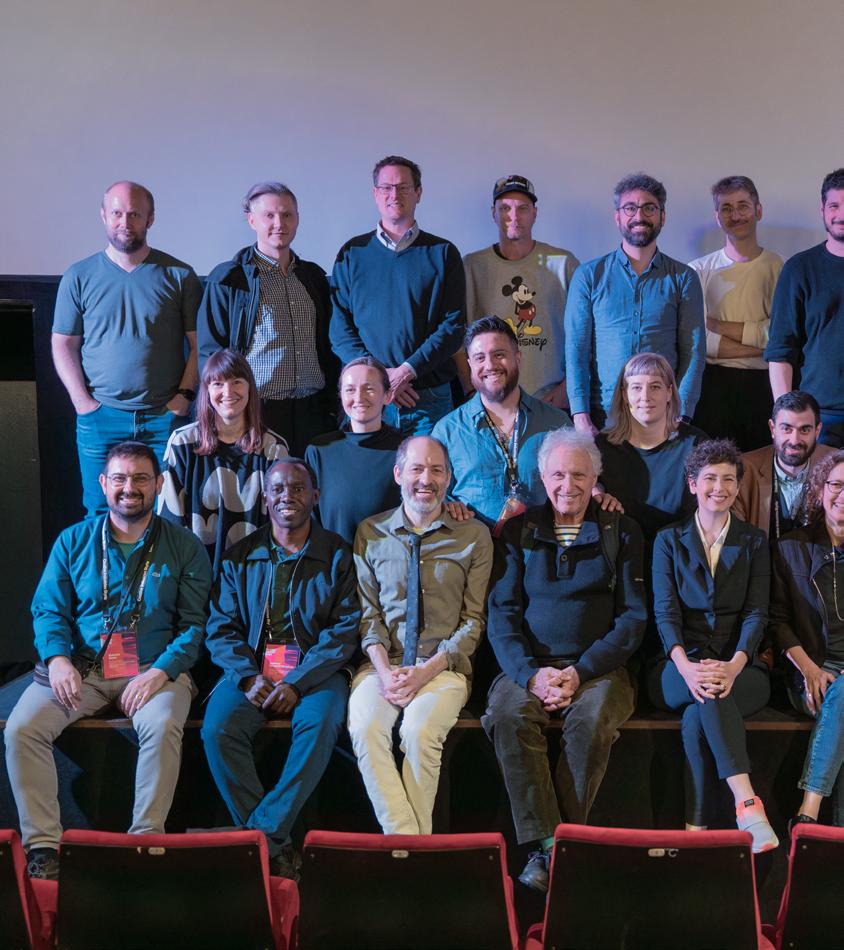

77

FH JOANNEUM
Institute for Design and Communication
Alte Poststraße 152
8020 Graz, Austria
T: +43 316 5453 – 8600 oder 8628
E: idk@fh-joanneum.at
layout and photos: Lena Kernbichler
Hanna Schild




















 MATTHIAS BEYROW, PROFESSOR, DEPARTMENT OF DESIGN, POTSDAM UNIVERSITY OF
MATTHIAS BEYROW, PROFESSOR, DEPARTMENT OF DESIGN, POTSDAM UNIVERSITY OF






 LAURA GALVANETTO CMSI23
LAURA GALVANETTO CMSI23
































 MICHAEL
MICHAEL






















 HANNA WEICHSLER CMSI23
HANNA WEICHSLER CMSI23


















 SELINA PARZAUNER IND23
SELINA PARZAUNER IND23



























 VIKTORIA KATTNER IND23
VIKTORIA KATTNER IND23















 NITZAN WAISBERG
NITZAN WAISBERG




 AIMEE NEYA CMSI23
AIMEE NEYA CMSI23




















